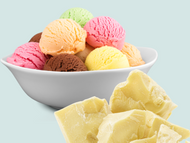Why Cacao Butter Belongs in Your Vegan Ice Cream
Jul 9th 2025
As the demand for vegan products is on the rise, competition is getting tougher. It’s no longer enough to have a decent plant-based option available. Icy and bland simply will not do in this day and age. It needs to be smooth, silky, creamy, and just as good, or better, than regular ice cream. How can this be accomplished?
Two words: Cacao butter.
As you know, cacao butter is the fat extracted from the cacao bean. It’s solid at room temperature, but melts at human body temperature– a testament to nature’s perfect design. This unique fat profile makes it ideal for products that should melt in the mouth, and not in the freezer. It’s a fat that does not separate or become grainy over time, and resists bloom or separation in emulsified bases. Plus, it doesn’t leave a greasy residue like other plant fats.
Let’s not forget about the health factor. As people are more concerned about their health, they are becoming pickier than ever, so any oil won’t just do. Many are avoiding highly processed or refined oils, especially those extracted with chemical solvents like hexane. These highly processed oils tend to be high in unstable polyunsaturated fats and contribute to inflammation. Cacao butter is naturally stable and minimally processed: free from solvents, bleaching agents, etc. In fact, stearic acid is one of the main fatty acids in cacao butter, which is considered a beneficial saturated fat. It has no significant impact on LDL (“bad”) cholesterol, and it’s metabolized into oleic acid in the liver. Stearic acid is resistant to oxidation, making it less likely to cause inflammation in the body. So not only does cacao butter align with performance goals, but it also provides a benefit to health.
In regards to texture: Traditional dairy ice cream relies on milk or cream for its deliciously smooth texture. It’s difficult to replace milk fat, since most plant-based milks are low in fat and high in water, which results in icy textures, fast melting, lack of richness and overall poor body.
There are two options when dealing with cacao butter: natural pure prime pressed and deodorized. Keep in mind that our deodorization process is very simple: we don’t ever use any chemicals or bleaching agents. We use a counter-current steam process, which simply removes most of the odor. It is still completely natural, just without the strong chocolatey aroma. If you want an aromatic earthy flavor such as chocolate or mocha ice cream, go with the natural pure prime pressed cacao butter. For other flavors, we suggest working with the deodorized option.
How to Use Cacao Butter in Vegan Ice Cream
Every recipe is different, but here are some of our tips.
- Melt it gently: Cacao butter should be melted over low heat, preferably in a double boiler to avoid damaging its structure. You don’t want it to burn or to crystallize unevenly. Once melted, incorporate it to your liquid base while still warm, before blending it all together.
- Use 2 to 10% of your total base (depending on your fat sources and desired richness): Cacao butter is 100% fat, and vegan ice cream generally needs about 8 to 14% total fat to achieve a desirable, creamy texture that’s optimal for scooping. If your base also contains ingredients that have fat in them, such as coconut or cashew cream for example, or any type of nut butter, you can use 2 to 6% cacao butter. If you’re using plant-based milks that are low in fat such as almond or oat milk, then you’ll want to go higher, since cacao butter will be your main fat– about 6 to 10% (possibly more, depending on your desired richness), but that’s where formulation comes into play. It’s all about trial and error, but keep in mind that too little fat can result in an icy or thin texture, and too much fat can result in being too waxy.
- Pair with other plant-based milks or creams: Like mentioned above, cacao butter needs a little support. It holds up longer and emulsifies better when paired with other creamy bases such as oat, cashew, or coconut milk or cream. If you go for watery milks like almond or rice, you will most likely need a stabilizer or secondary fat.
- Blend thoroughly: The fat must be evenly distributed to prevent separation during freezing. If your recipe is prone to breaking and you need stabilizers, some options are agar, guar gum or arrowroot. You could also use lecithin (~0.2%).
- Chill before you churn: You want your base to cool completely before churning, so the cacao butter crystallizes evenly.
Here is a cheat sheet that may help you in the process:
Icy texture → Not enough fat
Waxy/ greasy mouthfeel → Too much fat
Fat separation → Weak emulsion/ poor blending
Gritty feel → Overheated cacao butter
As always, feel free to contact us for tips, questions, or to talk cacao!

